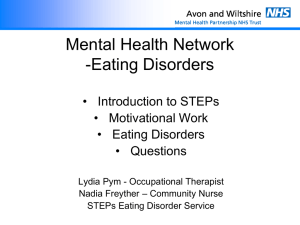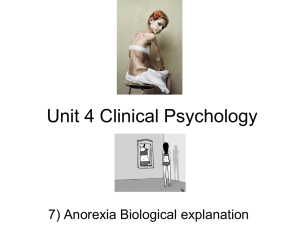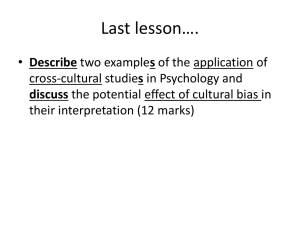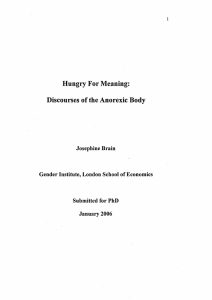Research Paper - Valdosta State University
advertisement
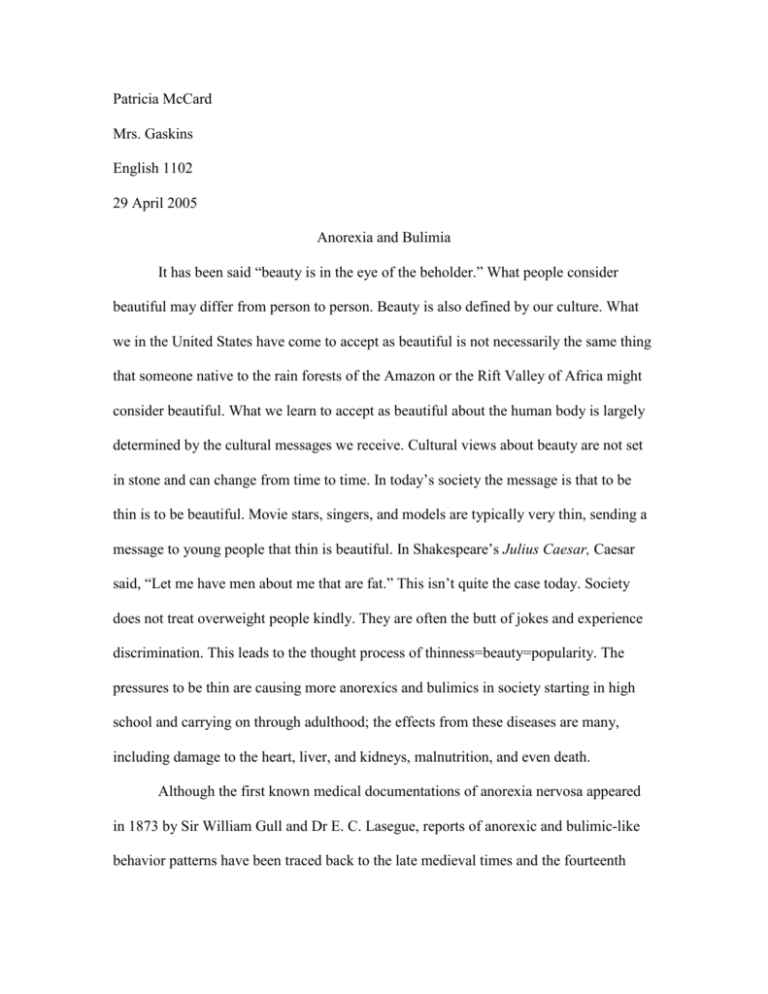
Patricia McCard Mrs. Gaskins English 1102 29 April 2005 Anorexia and Bulimia It has been said “beauty is in the eye of the beholder.” What people consider beautiful may differ from person to person. Beauty is also defined by our culture. What we in the United States have come to accept as beautiful is not necessarily the same thing that someone native to the rain forests of the Amazon or the Rift Valley of Africa might consider beautiful. What we learn to accept as beautiful about the human body is largely determined by the cultural messages we receive. Cultural views about beauty are not set in stone and can change from time to time. In today’s society the message is that to be thin is to be beautiful. Movie stars, singers, and models are typically very thin, sending a message to young people that thin is beautiful. In Shakespeare’s Julius Caesar, Caesar said, “Let me have men about me that are fat.” This isn’t quite the case today. Society does not treat overweight people kindly. They are often the butt of jokes and experience discrimination. This leads to the thought process of thinness=beauty=popularity. The pressures to be thin are causing more anorexics and bulimics in society starting in high school and carrying on through adulthood; the effects from these diseases are many, including damage to the heart, liver, and kidneys, malnutrition, and even death. Although the first known medical documentations of anorexia nervosa appeared in 1873 by Sir William Gull and Dr E. C. Lasegue, reports of anorexic and bulimic-like behavior patterns have been traced back to the late medieval times and the fourteenth century. Like modern anorexic patients some fourteenth century women starved themselves into emaciated conditions. However, the reasons for starvation were different from what they are now. Today the reasons offered for self-starvation relate to a person’s perception of body size and what they consider to be fat. In the medieval times the reasons for starvation were based on religious beliefs. In those centuries life was very hard and often very short. As a result, people’s thoughts often turned to the next world where they felt things had to be better. They attempted to make themselves more pure by acts of self-denial and self-punishment. Catherine of Siena, a fourteenth-century woman, scalded herself, struck herself, and slept on a bed of thorny substances. She only ate a handful of herbs each day which is similar to anorexic behaviors and sometimes she shoved twigs down her throat to throw up food that she was forced to eat, which is a behavior similar to that of bulimia nervosa. Interest in bulimia grew out of research on anorexia. Researchers found that patients that were considered to be anorexic were taking up binging and purging routines. Then, they were known as “vomiters and purgers”. There were many different names such as: dysorexia, bulimarexia, and dietary chaos syndrome that were proposed for this newly recognized disorder, but eventually researchers settled on the name “bulimia nervosa”. During the 1970’s bulimia nervosa was first recognized as a separate eating disorder from anorexia nervosa. It started with self-doubts and her boyfriend’s admiration of skinny thighs. Claudia, five feet, two inches tall and weighing 105 pounds, started an innocent, simple diet that developed into an unstoppable momentum. Losing 30 pounds in the first six months, Claudia said she was trying to maintain the weight of a 10 year old. She started dividing her food into smaller portions and began eating less and less. She even brought her meals into her room and then flushed them down the toilet. Her weight had fallen to 70 pounds, when a man on the subway saw her and called her a “walking skeleton”. She then took action and survived anorexia and eventually recovered her health. Anorexia nervosa can be defined as an eating disorder in which people intentionally starve themselves. Anorexia nervosa is primarily a disorder of young women and adolescents. Elke D. Eckert said, “The cardinal feature of anorexia nervosa is a relentless pursuit of thinness, often leading to life-threatening weight loss. This pursuit of thinness becomes associated with intense fears about eating, gaining weight, and getting fat and with fear of loss of control over food intake.” Anorexia nervosa is characterized by severe restrictions of food intake, loss of body weight to an unhealthy level, loss of menstrual periods (female), and a disturbed body image-still regarding self as fat despite being underweight. Although predominantly found in young females, males can also develop anorexia nervosa. The dietary patterns of males and females with anorexia nervosa are remarkably similar. However, male patients are more likely to be hyperactive than females. Anorexic patients display hyperactivity in various ways. They may intensify an existing interest in a sport by pursuing it with an obsessive quality, or they may develop a highly ritualized and structured exercise program. People with hyperactivity are always busy, moving around and almost never sitting down until late at night. A person with this eating disorder will show obsession with what he or she eats and is usually in denial about having the disorder. Even though a person with anorexia may be losing weight at a dangerous rate, they don’t see themselves as thin. The warning signs of anorexia include: withdrawing from social activities, excessive exercise, denying feelings of hunger, and dropping weight to about 20% below normal. The effects of anorexia can result in serious health problems such as: drop in blood pressure, pulse, and breathing rate, lack of energy, anemia, swollen joints, brittle bones, hair loss, soft hair called lanugo to grow all over the skin, and weak fingernails. One of the biological factors involved in anorexia is abnormal serotonin activity. Serotonin is a chemical used in transmitting signals to the brain. In severe cases of anorexia the brain can shrink causing personality changes or death may result. About 10 to 15 percent of patients with anorexia will die as a result of their condition, and many who do survive do not make full recovery. Since eating disorders involve both the mind and body, dieticians, mental health professionals, and medical doctors are often involved in treatment and recovery. Recognizing and addressing the problem is the most critical aspect when it comes to treating an eating disorder. Bulimia nervosa is an eating disorder in which people eat large amounts of food and then try to get rid of it by vomiting, by using laxatives or diuretics, or by fasting or exercising regularly.



